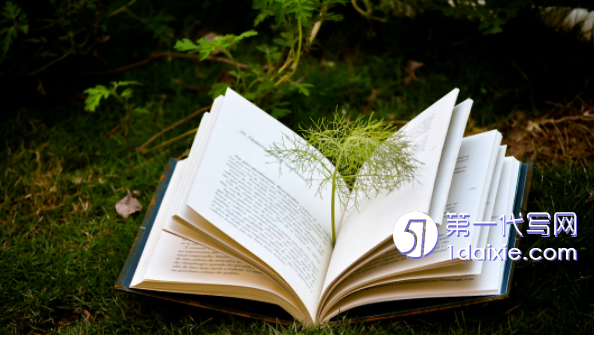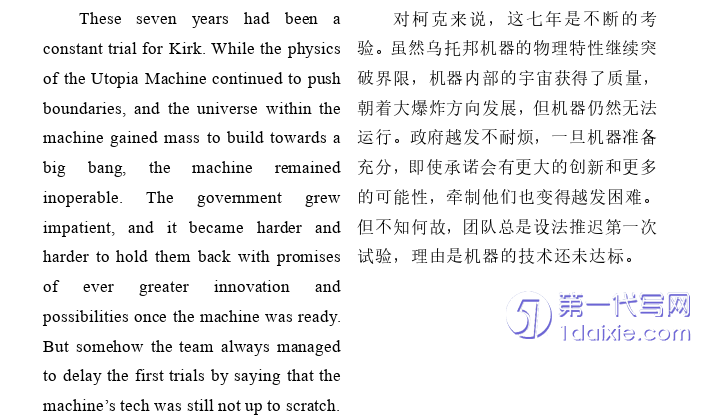本文是一篇英语论文,本次翻译实践以耶夫·维索尔伦提出的顺应论(adaptation theory)为指导理论,译者结合案例分析,从词句、句法、语境多重方面对翻译难点进行归纳和总结,探讨在翻译实践过程中如何运用顺应论实现译文的可读性、连贯和流畅。
Chapter One Overview of Report
1.1 Background of This Report
It’s widely accepted that the Industrial Revolution set the stage for real sciencefiction in the 18th century when the theme of this era was scientific innovation andtechnical revolution.People living in that era tended to consider the relationshipbetween human beings’fate and science technology,and this phenomenon wasreflected in literature,which formed the basis of today’s scientific fiction.Over thecourse of more than one century,science fiction has been explored more possibilitiesin terms of genres,especially since the turn of the 21st century.
By virtue of the Third Revolution of Science and Technology,science andtechnology in various fields has made great advancement,and science fiction as aliterary style concerning the future of humankind and scientific technology has alsobeen experienced a golden age.In particular,science fiction works in the 21st centuryhave shown colorful facets and multiple genres such as Space Opera,Future Epic,Ethics of Technology,Ethics of Civilization,Cyberpunk,Steampunk,Time Travel andAnti-Utopia,etc.More importantly,science fiction has presented a positive awarenessof intervention in reality in this era,and the ways of expressing science fiction havebeen expanded.Therefore,the significance and meaning of science fiction has beendeepened greatly.

1.2 Significance of This Report
The discussion of the importance of this translation report is divided into twoparts:the meaning of the translation material and the practical value and significanceof translation practice.
This translation material falls into the science fiction category and is excerptedfrom Chapter 8 to Chapter 12 of Sofia and the Utopia Machine by Judith Huang fromSingapore.The relationship between China and ASEAN is getting closer,and thecultural exchange is deepening.Although the translated and published works ofSoutheast Asian literature,represented by Singapore literature in China,are numerousand have a strong reputation,their influence far exceeds literature itself,whereasscience fiction works from ASEAN are rarely seen in China.However,this book,Sofia and the Utopia Machine,is set in future Singapore,where there are three socialstrata of people living here.The female heroine,Sofia,a teenage girl from theMidlevel class,accidentally gets involved in an alternative world through the UtopiaMachine one day and becomes the goddess of that world,beginning a series ofadventures.This book integrates the Utopia genre and feminism,illustrating theauthor’s reflection on the concept of Utopia and where Singapore society movestowards in the future from a young female’s perspective.
Chapter Two Translation Process Description
2.1 Introduction to the Material
Judith Huang is a multimedia creator,artist,author,editor,translator and so on.She is well-educated and a three-time winner of the British Poetry Society’s FoyleYoung Poet of Year Award.Judith Huang graduated from Harvard University with anA.B.in English and American Literature and Language on a Loke Cheng KimFoundation Scholarship.She has translated many science fiction works by Chinesewriters,such as The Final Test by Ti Sha,Rat’s Tongue by Xin Fan,and A Mountainof Dust by Wangxiang Fengnian,and so on.The Sofia and The Utopia Machine isJudith Huang’s first novel.
Sofia and the Utopia Machine depicts an ordinary school girl,Sofia,living in thefuture Singapore where society is divided into three social categories,and sheinadvertently unlocks the gateway to a new world through the Utopia Machine oneday.Sofia realizes she must escape from the government’s radar,so she starts to runaway with eccentric Uncle Kirk and Father Lang.While on the run,she gets closer tothe truth about the Utopia Machine and why her father disappeared seven years ago.
The translator chose from Chapter 8 to Chapter 12 of this book as the translationmaterial of the report.The content of the five chapters talks about Sofia accidentallycreating a new universe through the Utopia Machine in her mother’s secretgovernment,Biopolis Lab,and she enters the new world,experiencing a wonderfuland fantastic adventure there.Meanwhile,the government has noticed what happenedin the lab and listed Sofia as wanted.Sofia’s mother,Clara,is arrested byISD(Internal Security Department of Singapore)because of Sofia.
2.2 Difficult Points in Translation
The difficult points that the translator encountered during the translation processare divided into three parts.
For lexical difficulties,the translator needs to explain many nouns such asescapod,Midlevel class,Netbox,Jewelled Blue Crab and so on coined by the authorof the source text due to this novel being science fiction.The translator also needs toexplain the usage of implication and innovative words in the original text,whichrequires the translator to exert her imagination without deviating from originalmeaning to ensure the quality of translation.
For the syntactic part,it is not easy for the translator to understand these abstractsentences when the hypotactic and redundant sentences exist.Moreover,due to thecharacteristics of English and Chinese,it is necessary for the translator to use avariety of translation techniques to split long sentences and adjust word order toachieve the final translation,and apply Chinese four-character expressions to cater tothe targeted readers’reading habits.
Chapter Three Theoretical Framework ................................... 6
3.1 Brief Introduction to the Adaptation Theory ............................. 6
3.1.1 Four Aspects of Language Adaptation ....................... 6
3.1.2 Three Properties of the Adaptation Theory ..................... 7
Chapter Four Case Analysis ....................................... 11
4.1 Adaptation at Lexical Level .............................. 11
4.2 Adaptation at Syntactic Level ......................... 15
4.3 Adaptation at Contextual Level ............................. 21
Chapter Five Conclusion ............................ 27
5.1 Gains ..................................... 27
5.2 Limitations ................................. 27
Chapter Four Case Analysis
4.1 Adaptation at Lexical Level
In English,a word is the minimal but indispensable unit in a sentence or even a text,playing an important role in conveying information.In the translation process,thetranslator encountered some words in the source text that contain implicit meaning.Whenthis happened,the translator needed to make a translation strategy wisely in order not to letthe implicit meaning disappear when the source text was translated into another language.Due to the category of the translation material,the author created some expressions withsurreal elements herself using Singlish(Singaporean English)and some blurry expressionsin the source text,so the translator was supposed to consider this fact and then translatedthem in a proper way.The following part presents how the translator combined theadaptation theory with translation practice at the lexical level.
Example 1
ST:Sofia stopped short in shock and saw herself.She did not look like hernearly-15-year-old self,yet it was unmistakably her...The woman who was her had limbsand a face that extended eternally timewise.
TT.1:索菲娅震惊地停住了脚步,看到了自己。她看起来不像将近15岁的自己,但这显然是她...那个属于她的女人有着四肢和一张永远随着时间推移而延伸的脸。
TT.2:索菲娅震惊地停下来,竟看到了她自己。这个“索菲娅”看起来不像快十五岁的自己,但毫无疑问,这正是她本人。“索菲娅”的四肢和脸庞都随着时间的推移而无限延伸。

Chapter Five Conclusion
5.1 Gains
The translator chose to translate from the eighth chapter to the twelfth chapter ofSofia and The Utopia Machine by Judith Huang with the application of adaptationtheory from Jef Verschueren.Due to the practice of translation,the translator hasgained tremendously.
Firstly,it is the first time that the translator has tried to translate science fictionwork,which requires a basic understanding of science fiction elements and writingstyle,as well as grasping the essence of the original work.
Secondly,adaptation theory allowed the translator to access the core of thetheory which stresses the importance of adopting flexible and proper translationchoices to render the translation more adaptable and readable to the target audience.The techniques such as restructuring,literal translation,free translation,omission,re-sequencing(as seen in examples 10,11,and 23)were employed to bridge thelinguistic and cultural differences between Chinese and English in the practice oftranslation.Due to the differences between English and Chinese and to better conveythe meaning of the source text to Chinese readers.
Additionally,the translator has a more deep knowledge that the practice ofpost-editing is necessary to refine the initial translation and to identify potentialmistakes and shortcomings.Proofreading during post-editing ensured that thesentiment and information of the original work were conveyed accurately.
reference(omitted)
